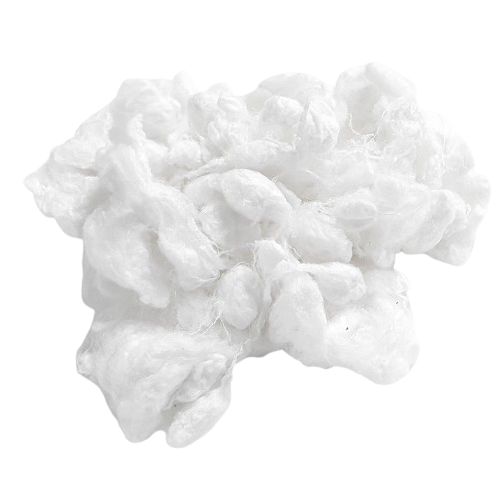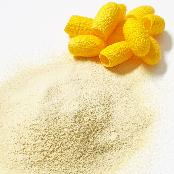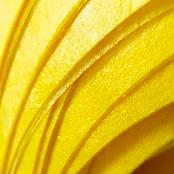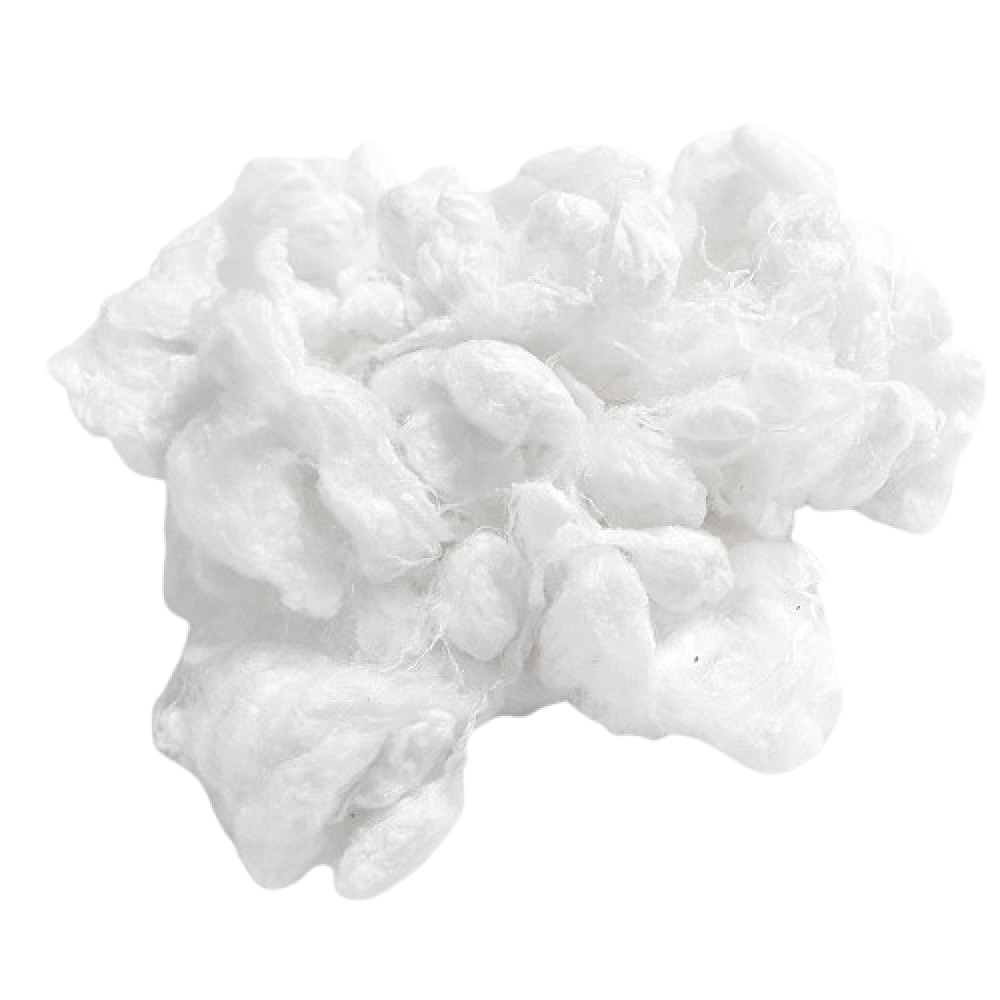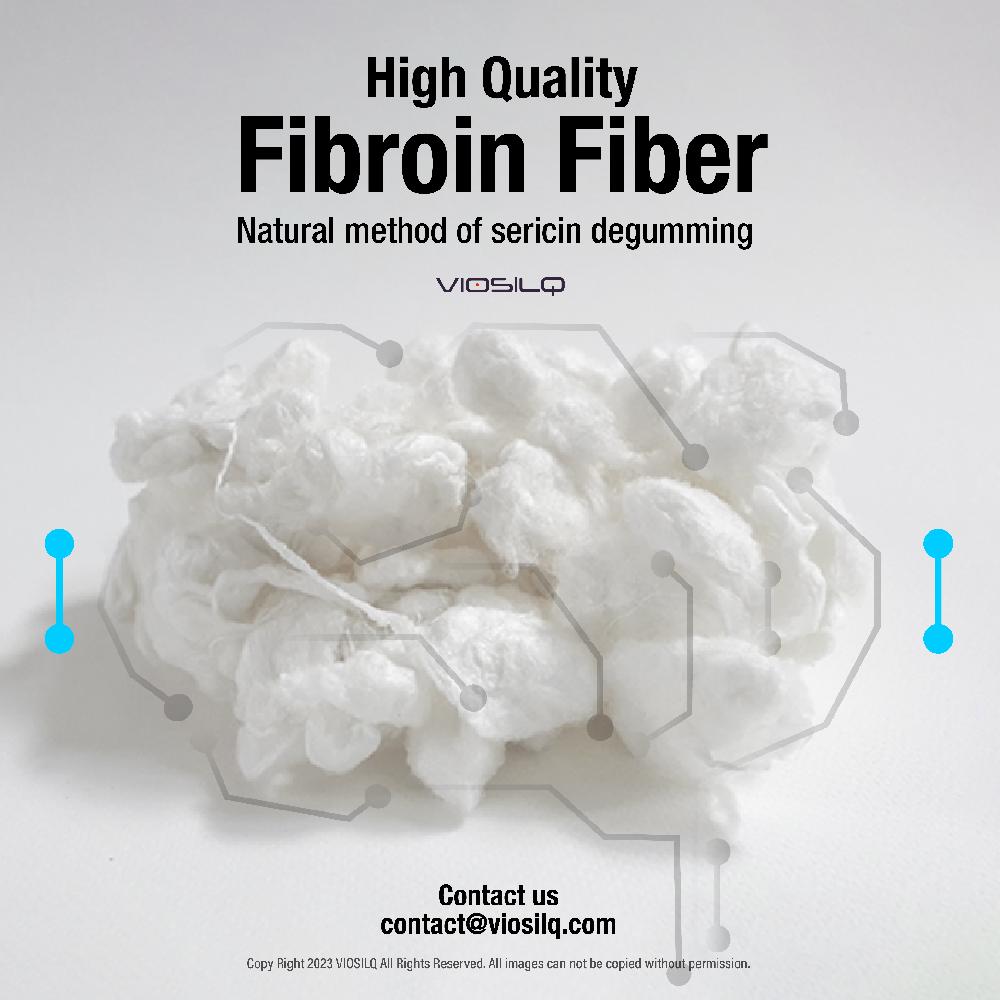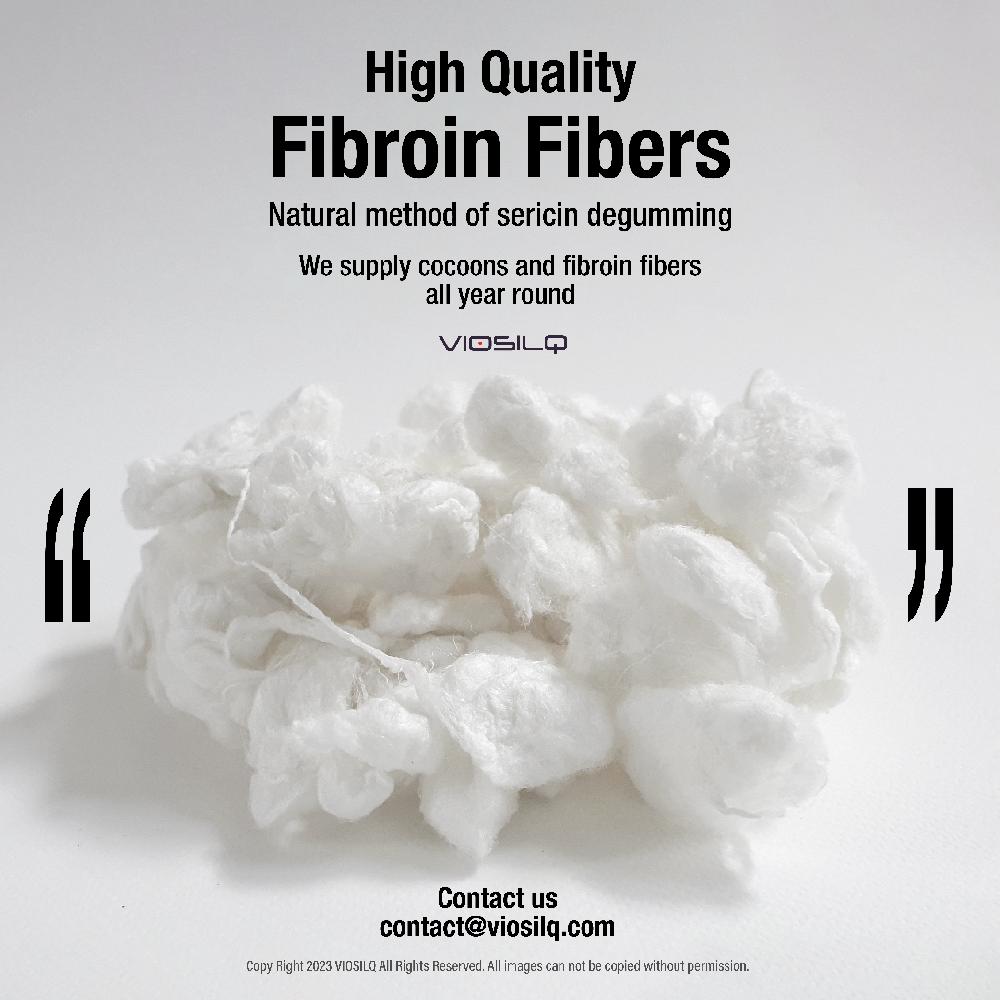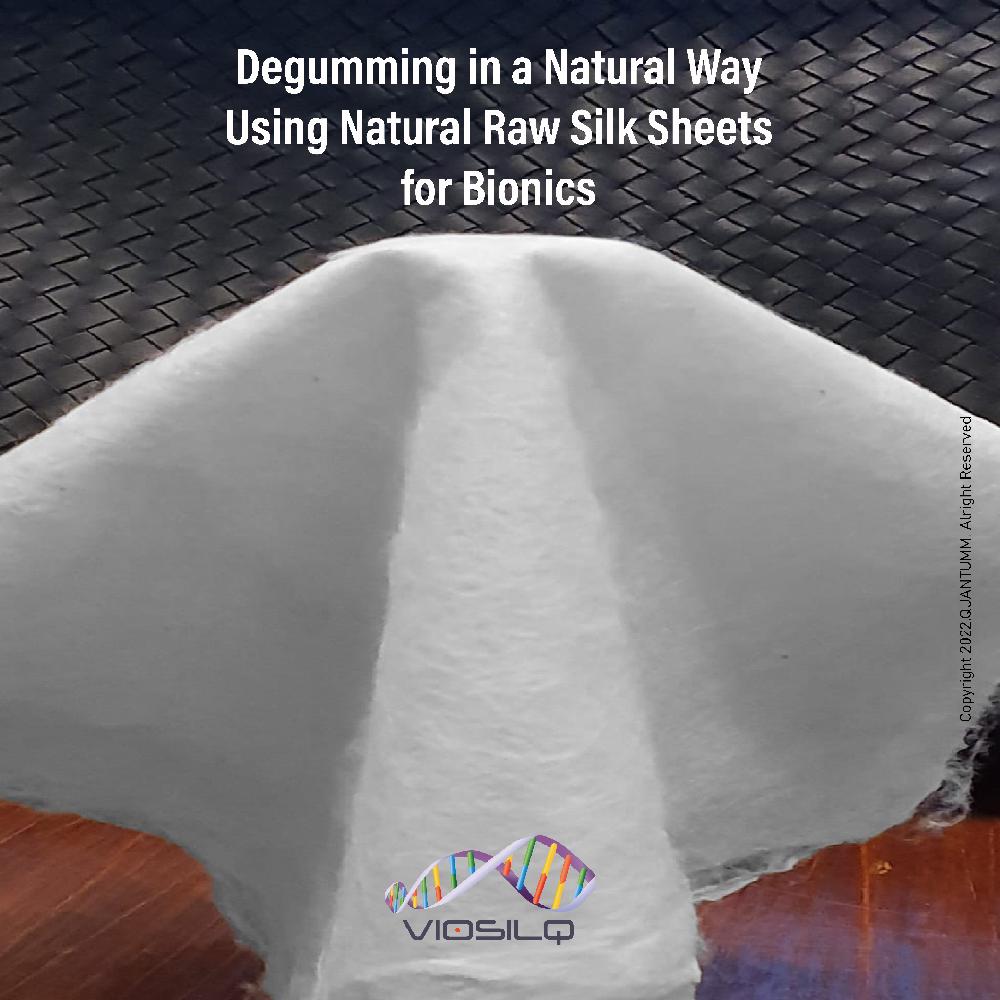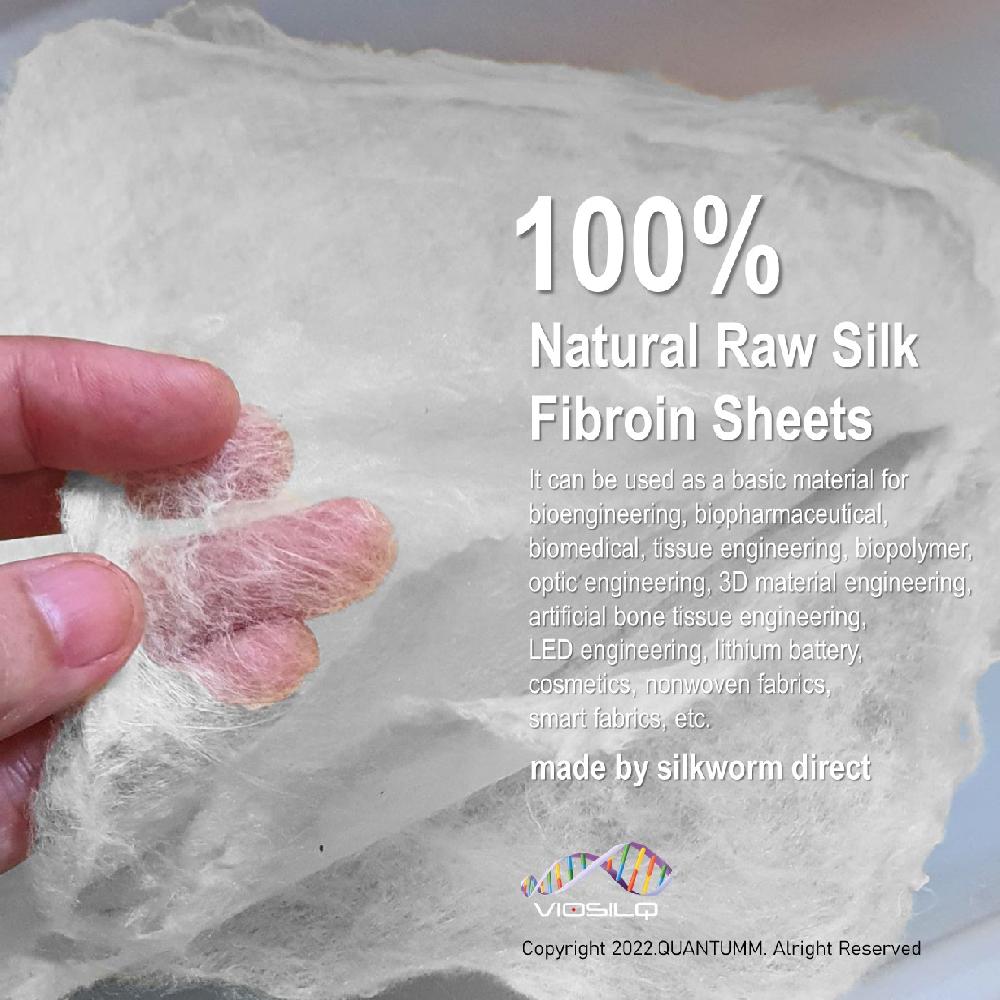ITEM SPECIFICS
-
Brand
Model VIOSILQ FIBROINVIOSILQ
-
origin
Republic of Korea
-
Size(Capacity)
1kg
-
Color
White
-
Condition
Premium Quality
-
Material
Raw Silk
-
Weight
1kg
-
Function
Basic materials for cosmetics and bioengineering
PRODUCT DESCRIPTION
Silk Fibroin Fiber
Premium VIOSILQ Silk Fibroin Fibers of Unmatched Quality
Along with cocoons, we also produce fibroin fibers, sericin peptides, and especially raw silk non-woven fabrics produced directly by silkworms all year round.
VIOSILQ is ready to supply premium-quality products that customers want and can develop new products in collaboration with customers.
VIOSILQ Fibroin Fiber, extracted from pure silkworm cocoons, is produced through the latest production process and can be used in various applications, from the bioengineering industry to bio cosmetics.
Fibers and textiles play an important role in the development of human society and our daily activities. Innovations related to flexible electronics, such as smart fibers and textiles with sensing, thermal regulation, and energy management capabilities, are generating great interest in both academia and industry. Smart textiles are revolutionizing personal health care and social activities with intelligent wearables.
Smart textiles that sense, interact with, and adapt to environmental stimuli have opened up exciting new opportunities for a variety of applications. However, current advances remain largely in the research phase because of the high cost, the complexity of manufacturing, and the inconvenience of environmentally sensitive materials. In contrast, natural raw silk fiber materials are more attractive for smart textiles due to their low cost and comfort advantages.
Water fog and humidity-driven torsional and tensile actuation of thermally set twisted, coiled, plied silk fibers, and woven textiles from these silk fibers are reported. When exposed to water fog, the torsional silk fiber provides a fully reversible torsional stroke of 547° mm−1. Coiled and thermoset silk yarns provide a 70% contraction when the relative humidity is changed from 20% to 80%. Such an excellent actuation behavior originates from water absorption-induced loss of hydrogen bonds within the silk proteins and the associated structural transformation, which are corroborated by atomistic and macroscopic characterization of silk and molecular dynamics simulations. With its large abundance, cost-effectiveness, and comfort for wearing, the silk muscles will open up additional possibilities in industrial applications, such as smart textiles and soft robotics.
The raw silk fiber is spun from the two glands of the silkworm and is composed of two primary filaments, which comprise fibroin proteins. The brins are glued together to form a base with sericin proteins, which also serve as an adhesive to construct the overall structure of the cocoon, supporting information. The two fibroin filaments near the fiber center are bound together and overcoated with the sericin. The fibroin consists of highly ordered beta-pleated sheets (β-sheets), which assemble because of strong hydrogen bonding and salt linkages between the side groups of the polypeptide chains. These properties make raw silk an ideal candidate for preparing water-actuated artificial muscles for smart textile applications.
A. Application Product Line
VIOSILQ is used as a basic material for bioengineering, tissue engineering, smart fabrics, biocosmetics, decoration goods, and household goods.
B. Product Production
- Annual production and Supply
- Customized production available
Application of Silkworm Cocoon Materials in Various Fields
Silkworm cocoons are used in various fields such as nonwoven fabrics, silk fibers, smart fibers, medicines, health foods, secondary batteries, tissue engineering and polymers (artificial eardrums, artificial bones, artificial teeth, artificial retinas, artificial hearts), drug carriers, surgical threads, eco-friendly plastics, food preservation agents, wearable electronics, bedding, decorations, etc.
Sericulture Industry
Sericulture is an agricultural-based industry that cultivates silk to raise silkworms. The primary purpose of silkworms is to produce silk, which is economically important. The demand for natural silk is increasing worldwide. Silk is a high-value-added but small-scale product, accounting for only 0.2% of the world's total fiber production, and the world's silk production is 609,332 tons per year.
Structure of Silkworm Cocoons (Fibroin and Sericin)
Mature silkworms squeeze viscous fluid from two large glands in their bodies to make cocoons. This solution is extruded through two tubes in the silkworm head into a common spinneret. The viscous part (fibroin) is covered with another secretion (sericin) that flows from two other symmetrically arranged glands. These two components are released into the air and coagulate, forming a solid continuous filament, which is glued together. As a result of this spinning process, the fiber has two main parts: sericin and fibroin.
Physical and Chemical Properties
The silkworm cocoon is physically eco-friendly, very transparent, and has a well-organized structure. The silk filaments are about 900–1700 m long and 9–11 microns in diameter. The tensile properties of the silk fibers are stronger than those of steel filaments of the same diameter. The specific gravity of raw cultivated silk and raw throwing silk is 1.33 and 1.32 g.cm3, respectively. Silk fibers heated at 140°C are not affected for a long time and decompose quickly at 175°C. The strength and elongation of silk fibroin fibers decrease when the fibers are exposed to UV light. In terms of chemical properties, silk is insoluble in water at room temperature, but silk can lose weight when boiled at 100°C. Acids and alkalis can hydrolyze the polypeptide chains of the fibers.
Mechanical Properties
Silk has attracted extensive attention due to its excellent material properties and promising applications. Silkworm silk has been reported to have an excellent balance of strength (610–690 MPa) and toughness (70–78 MJ m−3 ), making it stronger than other biomaterials except spider silk and competitive with synthetic fibers. Natural silkworm silk is a novel alternative reinforcing material for engineering composites and exhibits excellent strength and toughness under ambient and cryogenic conditions due to its elastic-plastic deformation mechanism. The mechanical properties and reinforcing mechanisms of silk and silk fiber-reinforced polymer composites (SFRPs) are important for material design and applications.
Applications of Silk Materials
Bombyx mori silk has attracted extensive attention due to its natural mass production, excellent biocompatibility, and unique mechanical properties. Silkworm silk has been used extensively in textiles for thousands of years due to its glossy appearance, flexibility, and lightweight. Bombyx mori protein fibers are composite materials consisting of a semi-crystalline silk core, mainly silk fibroin, which is responsible for load-bearing capacity, and an outer x-layer of sericin, which acts as a saponifying agent. Fibroin imparts biocompatibility to fibroin, while sericin is digestible due to its protein properties and its propensity for the action of proteolytic enzymes present in the body. These properties make it biocompatible and biodegradable. Additional properties such as gelling ability, water retention capacity, and skin adhesion make it a widely used material in the medical, pharmaceutical, and cosmetic fields.
Silk as a Biomedical Material
Recently, there has been increasing interest in silk materials for biomedical applications such as biocompatibility, biodegradability, and self-assembly for unique physical, chemical, and mechanical properties. The smaller silk units, called fibroin fibers, have identical repeating amino acid sequences, which influence the protein chain structure and the properties of the silk material. These interesting properties of silk have significant biomedical applications.
Bombyx mori silk fibroin proteins can be subdivided into very large, light (≈26 kDa), and heavy (≈391 kDa) chains, which are linked by a single disulfide bond, and are used in medical applications. However, the very hydrophobic amino acids and antioxidant potential of sericin have applications in food and cosmetics. In the presence of moisture, silk can act as a therapeutic agent for wound healing, cell proliferation stimulation, UV protection, and in cream and shampoo formulations. The antioxidant activity associated with sericin's low digestibility increases its medicinal uses, such as antitumor, antibacterial and anti-inflammatory, anticoagulant, and colon health. Silk performance biocompatibility and biodegradability, use of silk in sutures, surgical meshes, and fabrics, clinical trials such as wound healing, tissue engineering, and novel biomedical applications such as silk solutions, films, scaffolds, electrospun materials, hydrogels, and particles. Extensive research in the field of tissue engineering on silk and silk regenerative properties is related to the impressive mechanical strength of silk. Based on these remarkable properties of silk such as high mechanical strength, biocompatibility, and degradability, it is used in the fields of tissue engineering and regenerative medicine.
The mechanical stability of scaffolds is essential for cells to attach, expand, divide, proliferate, and differentiate. Connective tissues such as tendons, ligaments, bones, and cartilage are also used. Furthermore, scaffolds have shown remarkable biocompatibility characteristics and are used as nanoscale structures for cell recognition and response. As a result, nanofibers are the most suitable form of artificial matrix to be considered in tissue engineering technology.
Electrical and Optical Devices
The electrical properties as a function of temperature and humidity have found applications in battery technology, biosensors, humidity sensors, steam engines, and waste heat management. Metal salts such as FeCl3 and ZnCl2 are derived from natural silk and act as effective activating-graphitizing agents during the dissolution process. In addition to hierarchical porous nitrogen-doped carbon nanosheets and electronic device applications, silk materials have shown great potential in optical applications due to their unique optical properties and diverse nanopatterned structures. Silk fibroin has also been used in various optical devices such as diffractive optical elements (DOEs) and light-emitting diode (LED) lenses. DOEs are attractive for labeled or unlabeled biosensing because their diffraction efficiency is easily influenced by chemical or biological molecules attached to them. Recently, fluorescent silk has attracted tremendous attention due to its potential in cell visualization and scaffold performance monitoring as a novel functionally modified natural biomaterial. Advances in genetic engineering have enabled the ability to produce fluorescent silks in various colors such as red, green, and orange.
Future Trends in Silk
Technologies that apply natural silk include the Internet of Things (IoT), enhanced wireless personal area network (WPAN) systems, image processing technologies and smart sensors, biosensor technologies, public-private partnerships (PPPs), establishment of silkworm banks, and sericulture startups.
We are ready to supply premium-quality products that customers want by OEM and ODM and we can develop new products in collaboration with clients. Please do not hesitate to contact us comfortably now.
contact@viosilq.com
R&D CERTIFICATE
PAYMENTS DETAILS
This supplier supports payments for offline orders
- Telegraphic Transfer : T/T
- Name : KIM TAEIL
SHIPPING
Shipping from :
Republic of Korea
- 20 Samseong-ro 103-gil, Gangnam-gu, Seoul (06155)
QUANTUMM CO. LTD.
The person in charge
TAEIL KIMAddress
20 Samseong-ro 103-gil, Gangnam-gu, Seoul (06155)
QRCODE
QUANTUMM CO. LTD.
Introduction
Quantumm Co. Ltd. is a world leader in the exclusive production of non-woven raw silk sheets using silkworms. Under the brand VIOSILQ, the production plant is located in Chiang Mai, Thailand, featuring a mulberry farm and year-round production facilities. This project is supported by the Queen Sirikit Department of Sericulture under the Ministry of Agriculture and Cooperatives of Thailand. VIOSILQ can be used as a fundamental material for bioengineering, smart fabrics, cosmetics, and daily necessities.
1. For the cosmetic:
-Features: 100% natural raw silk without chemical additives contains 16 kinds of living natural proteins that make the skin clear and smooth and help heal wounds.
-How to use: In the case of facial masks, it can be used alone after soaking in hot water without adding essence, and can be reused more than 10 times. Water-soluble proteins dissolved in hot water melt on the surface and naturally permeate the skin.
No side effects on the skin (Completed skin clinical trials).
-Products: Facial masks, belly masks, breast patches, sericin peptides.
2. For the bioengineering:
-Silk used as the basic material for bioengineering and can be supplied year-round.
-Products: Fibroin fibers, sericin peptides, silkworm cocoons.
3. For the smart fabric:
-Silk used as the basic material for smart fabric and can be supplied year-round.
-Products: Fibroin fibers, silkworm cocoons.
4. For the daily necessities:
-Features: Processed from 100% natural raw silk sheets, harmless to the human body. Sustainable products and biodegradable in nature.
-Products: Women's sanitary pads (need to be developed with partners), diapers (need to be developed with partners), sanitary tissues, coffee filters, tea bags.
-
- Business Type :
- Manufacturer
-
- Main Product :
- Natural Nonwoven Raw Silk Sheet
-
- Established :
- 2012-11-12
-
- Total Annual Revenue :
- Less than 100 million (KRW)
-
- Total Employees :
- Less than 5
R&D CERTIFICATE
-
- Dust collection efficiency first test
- GBT, KOREA, KFDA STANDARD
- 15MAY2020
- 인증서보기
-
- Dust collection efficiency second test
- GBT, KOREA, KFDA STANDARD
- 17JUL2020
- 인증서보기
-
- Air permeability test
- THTI, THAILAND, N STANDARD
- 14MAY2020
- 인증서보기
-
- Formaldehyde test
- THTI, THAILAND, N STANDARD
- 14MAY2020
- 인증서보기
-
- Filtration efficiency test(0.1um)
- RUEE, THAILAND, N STANDARD
- 18APR2020
- 인증서보기
-
- Filtration efficiency test(0.3um)
- RUEE, THAILAND, N STANDARD
- 18APR2020
- 인증서보기
-
- COA
- 인증서보기
-
- MSDS
Please suggest a variety of your ideas such as design, impact, enhancements, etc
Captcha Required
Please enter the text on the left image to prevent automatic input.
0 / 4000
질문이 없습니다.
CUSTOMER REVIEWS (0)
TRADE EXPERIENCE
-
- Total revenue
- Less than 100 million (KRW)
-
- Total export revenue (previous year in USD)
-
- Number of foreign trade employees
- Less than 5
COMPARISON TO SIMILAR ITEMS more
- No Items
- supplier level
-
 PLATINUM
PLATINUM
- QUANTUMM CO. LTD. Seller's Store
- Seller's Store url
- Response Level
★ ★ ★ ★ ★

- Supplier Level
★ ★ ★ ★ ★

- Transaction Level
★ ★ ★ ★ ★

